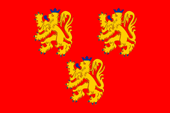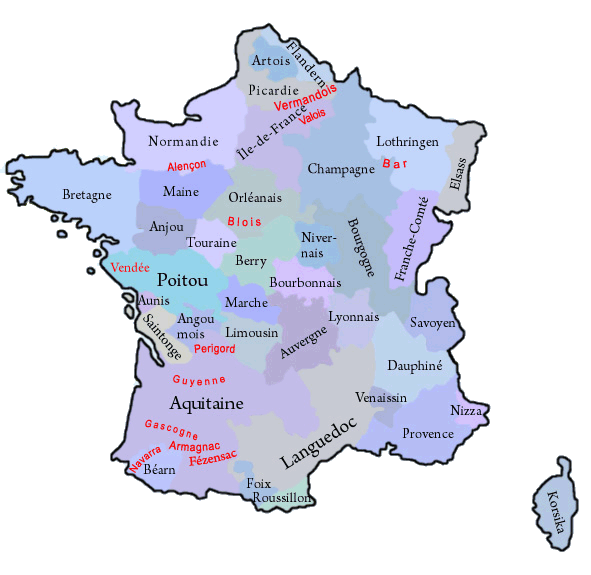mobile View, to the German Version tap the flag


- historical region in today's France
- former county and province
• Flag
• Meaning/Origin of the Flag
• Coat of Arms
• Meaning/Origin of the Coat of Arms
• Map of the historical Regions in France
• Explanations about the Regions
• History
• Origin of the Country's Name

Flag of Périgord
– drapeau de Périgord,
Source, by: fr.academic.ru




The flag of Périgord is a scutcheon-flag, its design is the image of that coat of arms of the ancient House of Périgord, which ruled for long times over the county.
Source:
Volker Preuß


Coat of arms of Périgord
– Blason du Périgord,
Source, by:
heraldique.org

to 1438,
Coat of arms of the House of Orléans
– blason de Maison de Orléans,
Source, by:
Wikipedia (D)

1438–1470, Blois-Châtillon
Coat of arms of the House of Blois-Châtillon
– blason de Maison de Blois-Châtillon,
Source, by:
geni.com

1470–1589, d'Albret
Coat of arms of the House of d'Albret
– blason de Maison d'Albret,
Source, by:
Wikipedia (FR)

1589–1607, de Bourbon
Coat of arms of the House of Bourbon
– blason de Maison du Bourbon,
Source, by:
Wikipedia (D)

The coat of arms of Périgord shows a red shield with three golden, blue armed lions. It seems that the origin of the crest appears to lie in the dark and was not find out. Maybe it goes back to the investiture by the English crown in 1360 by the Treaty of Brétigny, because lions were frequently given by the English in the coats of arms. The crest could also be of recent origin, because after all, one line of the family had survived into the modern era, which still uses this coat of arms, namely the House of Talleyrand-Périgord. The heraldry of the Périgord, however, is quite changeable, because the old line of the Périgord family died probably from quite early on, and was associated with the heraldry of their respective other country gentlemen. When King Philipp VI. of France (from the house of the Capetians) created the Duchy of Orléans and handed it over to his younger son Philipp of Valois, became the lily-scutcheon of the Capetians supplemented with a white tournament collar, which featured Philipp – following the rules of the French heraldry – as a younger son. The House of Orléans ruled in Périgord to 1438. Between 1438 and 1470, the House of Blois-Châtillon was enfeoffed with the County of Périgord. The House of Blois-Châtillon were powerful gentries who were temporarily enfeoffed with several counties, but never ascended to the high nobility. Their coat of arms showed a six-fold clefted shield, between red and blue and white iron helmets, and a golden shield-head, which is added with a black loepard for the Vice-Counts of Limoges. Between 1470 and 1589, the House of d'Albret was enfeoffed with the County of Périgord. Their coat of arms was squared - four times divided - and the first and third field showed three golden lilies on blue, and the second and fourth field was solid red. In 1589 the County of Périgord was selled to the House of Bourbon. The associated heraldry showed the blue, with golden lilies topped shield of the Capetians, which was covered with a red oblique-right bar. The coat of arms of the Capetians showed three golden lilies on blue, but originally was the coat of arms sprinkled with lilies. From 1365 (by others sources 1376), the number of lilies was reduced to three. The lily-symbol is very old, already the Germanic tribe of the Franks has used it. The House of the Capetians has provided the kings of France between 987 and 1328. It goes back to Hugo Capet, son of Hugo the Great, who was electet to the King of France, in 987, after the death of King Ludwig V. from the House of the Carolingians. The Capetians brought out three branch lines which became the Kings of France: Valois 1328–1589, Bourbon 1589–1792 and 1814–1830, and Orléans 1830–1848.
Source:
heraldique.org,
Wikipedia (FR),
Wikipedia (D),
Volker Preuß

The historical, French Regions:

in black: governorate and province in 1776,
in red: former county, province oder governorate
Map: Volker Preuß

The until the French Revolution existing provinces (or governorates) have been historically grown structures, which had their roots oftenly in former fiefdoms of the French crown, historic counties and duchies. They oftenly existed for hundreds of years and had preserved regionality (e.g. cultural particularities and regional languages). On the occasion of the French Revolution such phenomena were of course not desirable, and as part of their bloody and violent egalitarianism any regional references were eliminated. Shortly after the French Revolution the provinces were dissolved and France became divided into many départements, which should have approximately the same size and the same status. The départements were named after rivers or mountains, to use never and in no circumstances the name of an old province. However, there was no success in cutting the connections of the people of France to their respective regions, so that administrative regions were re-created in 1960, to have a better control in regional administrative processes. In this way became départements, which were placed in a historical province, administratively grouped to an oftenly historically named region. The resulted structures coincide only approximately with the boundaries of the old provinces. In the strictly centralist France any regionality is avoided, so that even the official flags of these regions mostly look like flags of companies, unloving, unhistorical, technocratic and modernistic, and these flags should not be a subject of any lexical considerations here. Only in a few of that regions, exist official flags which remember the historical models. But, even the existence of these today's regions is douptful, because in 2014 was passed a territorial reform valid from the year 2016, that reduces the number of the existing regions by merging to nearly the half. However, there exist unofficial flags in nearly all of these regions, which should remember the old provinces and the old heraldry.
Wikipedia Link to the regions of France:
click or tap here
FOTW Link to the regions of France:
click or tap here
Source: Flags of the World,
Wikipedia (D),
Volker Preuß

antiquity · settlement by Celtic tribes, the largest of them are the Petrocores (Petrocorii)
52 B.C. · Roman conquest, forming the province of Aquitania in the west of Gaul
418 A.D. · the Visigoths be settled as federates, Aquitaine belongs to their sphere of influence
5th century A.D. · conquest of Gaul by the Franks (under King Clovis) to 507 conquest of Aquitaine, expansion of the empire to the Atlantic Ocean, the Pyrenees and the Alps
771 · Charlemagne takes over Aquitaine and transmits it later as a kingdom to his youngest son Louis the Pious
778 · establish of the County of Périgord, the first mentioned Carolingian count is Wildbade
880 · by the division of the Frankish Empire (Treaties of Verdun and Ribbemont) arises the West Frankish Kingdom (later France), the East Frankish Kingdom (later German Empire), the Kingdom of Italy, the Kingdom of Upper Burgundy (under Rudolf the Welf) and the Kingdom of Lower Burgundy persists
950 · Aquitaine includes now the counties of Gascony, Armagnac, Fézensac, Périgord, Poitou, Angoulême and La Marche
1152 · Henry Plantagenet marries Duchess Eleanor of Aquitaine, the duchies of Aquitaine and Gascony come to the house of Anjou-Plantagenet
1154 · death of Stephen of Blois (King of England) , Henry is his successor as Henry II., Anjou becomes in this way a fief of the French king, which is a part of the crown of England (House of Anjou-Plantagenet)
1204 · Philip Augustus, King of France, conquers Normandy, Anjou, Maine and Touraine (Angevin Empire of the Plantagenets)
1224 · King Louis VIII. of France, son of Philip Augustus, conquers Aquitaine, except Gascony the last possession of the Plantagenets in France, Poitou and Saintonge come directly to the crown, La Marche, Périgord, Angoulême and Auvergne become fiefs
1328 · death of King Charles IV. (the Fair), extinction of the direct Capetian line, according to Salic Law Count Philip of Valois (Son of Prince Charles of Valois, first cousin of King Charles IV.) came on the French throne (as King Philip VI .), the English king Edward III. lays claim to the throne as a maternal nephew of Charles IV., reason for the "Hundred Years War" (Anglo-French War, 1338–1453), out of the House of Valois came all kings of France from 1328 to 1589
1360 · Treaty of Brétigny, Perigord comes to the English crown
1415 · Battle of Agincourt, Charles d'Orléans, Count of Périgord, is captured by the English and remains to 1440 in English custody
1438 · Charles d'Orléans sells the County of Périgord to Jean de Châtillon, Lord of Laigle, Count of Penthièvre and Viscount of Limoges
1453 · Battle of Castillon, the end of the Hundred Years War, the Kings of England have to cede all their possessions in France
1455 · death of Guillaume de Châtillon-Blois
1470 · Françoise, the eldest daughter of Guillaume de Châtillon-Blois, brings the county as a dowry in the marriage to Alain d'Albret
1526 · Marguerite d'Angouleme, widow of Charles IV of Alençon, marries Henri II. d'Albret, King of Navarre (House of Bourbon), her daughter, Jeanne d'Albret, later became the mother of the French king Henry IV.
1548 · Jeanne d'Albret marries Antoine de Bourbon
1555 · death of Henry II., the heritage, and in this way also the County of Périgord goes to his daughter, Jeanne d'Albret
1572 · death of Jeanne d'Albret, the heritage, and in this way also the County of Périgord goes to her son Henry III. of Navarre
1584 · Henry III. of Navarre sells his rights on the County of Périgord to his sister Catherine de Bourbon
1589 · death of Henry III., King of France, Henry III. had no descendants, extinction of the line of Valois, Henry III. determined Henry of Navarre (House of Bourbon) as his successor, which is as Henry IV., the Good, Henri le Bon, the new King of France
1607 · the County of Périgord becomes a part of the royal domain, and a province of France, but belonged later to the Provice of Aquitaine
1776 · the already in the 14th century created governorates of the civil administration of the kingdom of France become committed to a number of 39, and correspond in this way to the number of provinces, in previous years could any provinces be summarized in one governorate
1789 · French Revolution, the governorates and provinces become abolished, Aquitaine is divided into departments (approximately: Gironde, Dordogne, Lot, Aveyron, Landes, Lot-et-Garonne, Gers, Hautes-Pyrenees and Haute-Garonne)
1960 · reintroduction of regions in France, the Périgord doesn't play a role, affiliation with the newly created Aquitaine region (capital: Bordeaux), even not within the historic boundaries, just by integrating of the departments of Dordogne, Gironde, Landes, Lot-et-Garonne and Pyrénées-Atlantiques
2016 · the Aquitaine region merges with the Poitou-Charentes and Limousin regions in the new, larger region of New Aquitaine (Nouvelle-Aquitaine)
Source:
Wikipedia (FR),
Meyers Konversationslexikon

The name "Périgord" goes back to the Celtic tribe of the Petrocorii, who lived here in Roman times, and who gave its name to the capital Périgueux.
Source:
Meyers Konversationslexikon,
Volker Preuß


![]()









